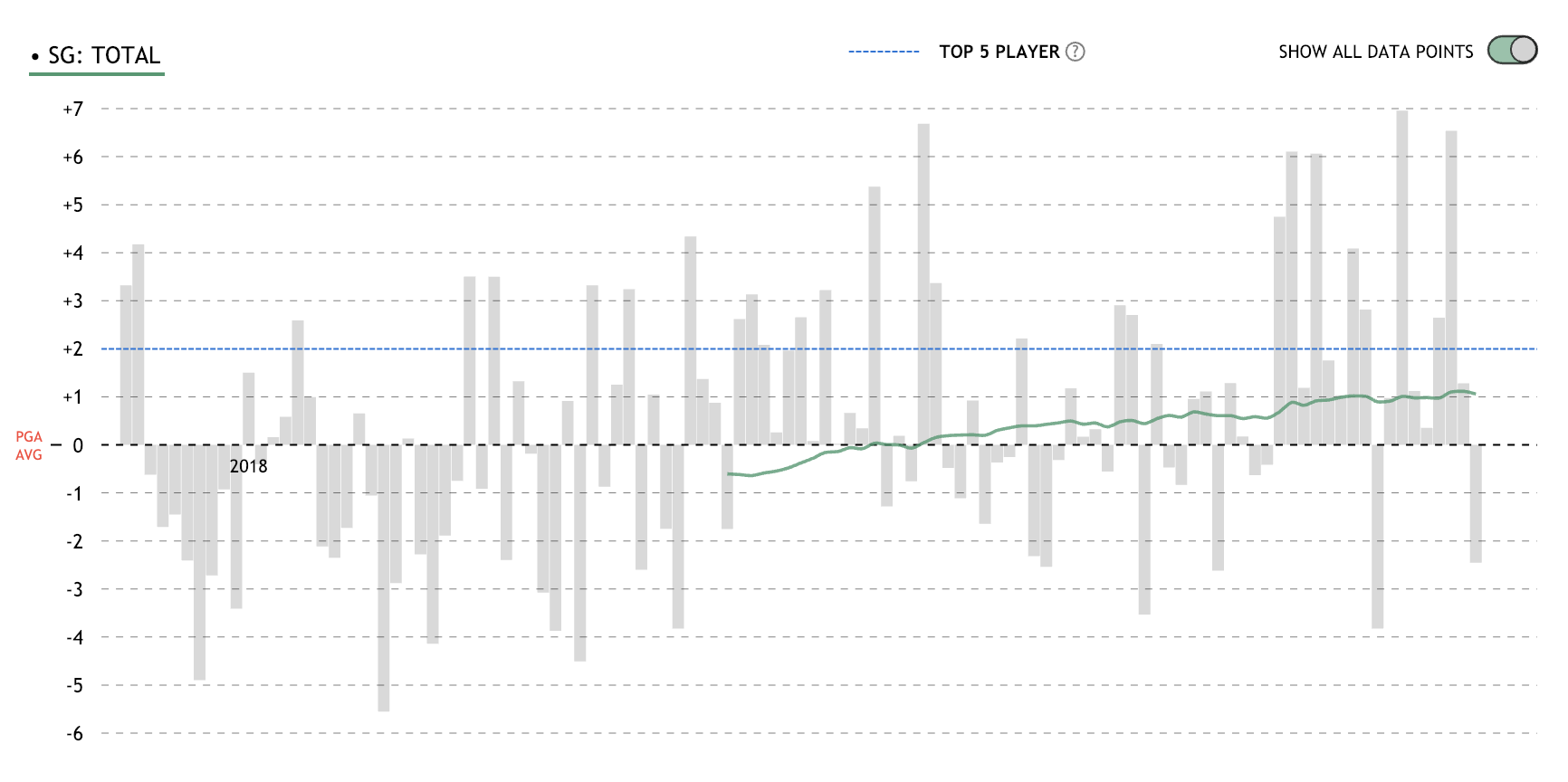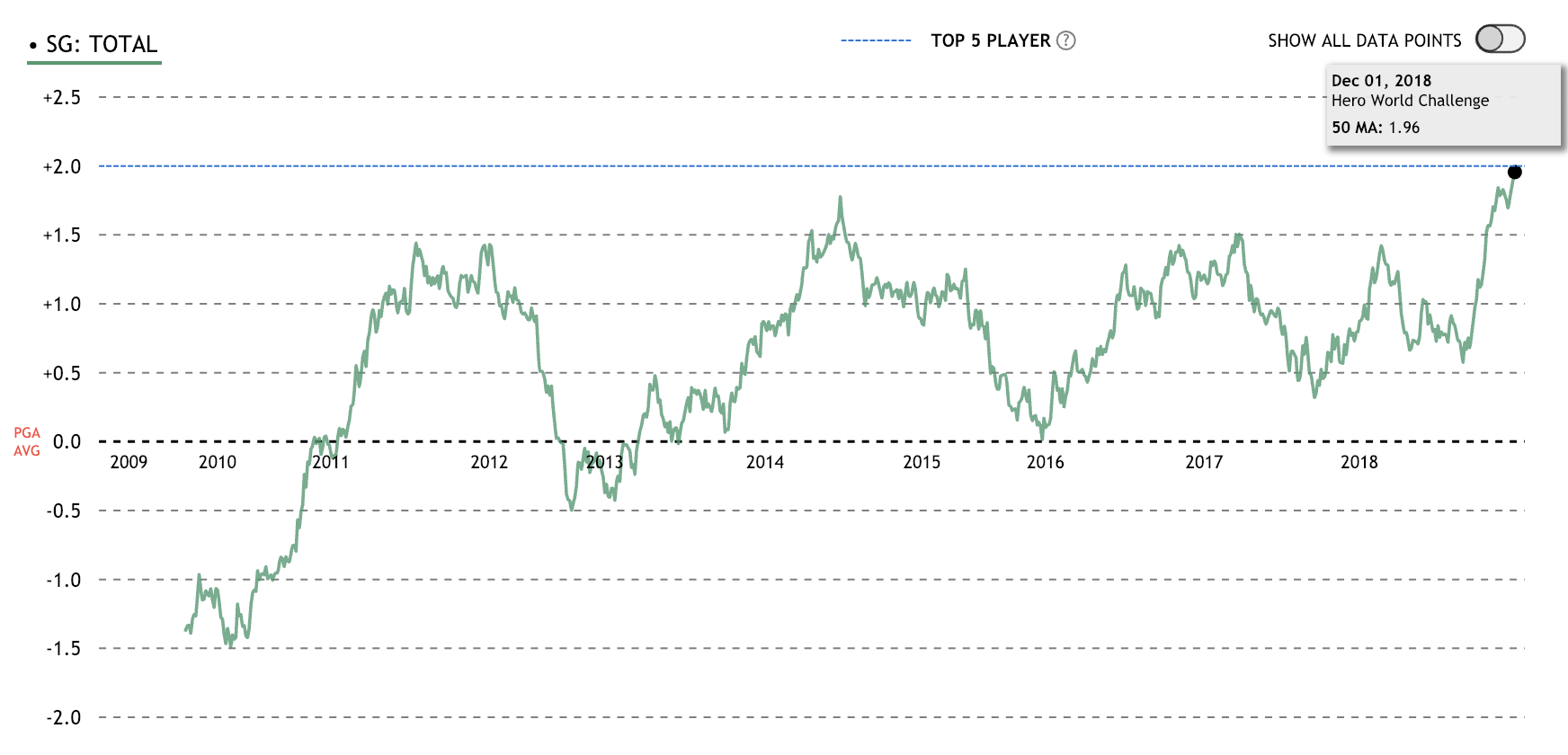• DG Betting Blog
Much of the discussion during the Fall Series surrounded PGA Tour newcomer and noted long-baller Cameron Champ. This attention was well-earned, as his rookie season began with 5 made cuts, 3 top 10s, and of course a win (Sanderson Farms) in his first five starts.
While his raw talent is undeniable, is it possible we are jumping the gun on Champ? It seems as though the media are eager to find the next Rory, Spieth, or DJ. The fact is, this type of player is incredibly rare and to be included in the same breath requires a sustained level of performance that is 1.5 to 2 shots better per round than the average PGA Tour pro.
With that being said, let’s take a look at how Champ has performed since turning pro back in 2017. The plot below (click here to visit interactive page) shows his true strokes-gained (this is just strokes-gained adjusted for field strength) in each round (grey bars) along with his 50-round moving average (green line). The beauty of this graph is that because we have adjusted for field strength, we can accurately compare his performances across different events and tours.
While his raw talent is undeniable, is it possible we are jumping the gun on Champ? It seems as though the media are eager to find the next Rory, Spieth, or DJ. The fact is, this type of player is incredibly rare and to be included in the same breath requires a sustained level of performance that is 1.5 to 2 shots better per round than the average PGA Tour pro.
With that being said, let’s take a look at how Champ has performed since turning pro back in 2017. The plot below (click here to visit interactive page) shows his true strokes-gained (this is just strokes-gained adjusted for field strength) in each round (grey bars) along with his 50-round moving average (green line). The beauty of this graph is that because we have adjusted for field strength, we can accurately compare his performances across different events and tours.
The first thing that stands out is how well Champ played in the fall series (last 20 bars on plot above) relative to his performance during last year’s Web.com season. Even though he won in Utah on the Web, his form was volatile and fairly average when compared to PGA Tour standards (True SG of 0 = PGATOUR average). During his run of good form in the fall, Champ averaged a true SG of 2.03 per round (across 20 rounds). This is a very high level of play, but 20 rounds is also a small sample size. Many players achieve this level of performance in short bursts throughout the year, but only the top players do it with sustained consistency.
This brings us to our first bet of the 2019 season, which is a tournament match-up between Cameron Champ and Gary Woodland. Bet365 is offering odds of 1.90 for both players (52.6% implied odds), but our model is showing a big edge in favour of Woodland (63% to win according to our model). Note that for tournament matchups if the golfers tie you lose the bet, so our 63% for Woodland is his outright win probability.
To understand why the model favours Woodland by such a large margin, let’s now look at his true strokes-gained plot below:
This brings us to our first bet of the 2019 season, which is a tournament match-up between Cameron Champ and Gary Woodland. Bet365 is offering odds of 1.90 for both players (52.6% implied odds), but our model is showing a big edge in favour of Woodland (63% to win according to our model). Note that for tournament matchups if the golfers tie you lose the bet, so our 63% for Woodland is his outright win probability.
To understand why the model favours Woodland by such a large margin, let’s now look at his true strokes-gained plot below:
Like Champ, Woodland also had a very strong finish to 2018 playing roughly at the level of a top 5 player in the world. Thus, even if we were going to predict future performance based on recent form alone, the edge would still go to Woodland. (Why this has gone largely unnoticed is a separate, and interesting, question.) However, a more important difference between Champ and Woodland is that Woodland has a proven track-record of consistent play dating back to 2014. Of course he has had his share of peaks and troughs, but for 5 years he has averaged around 1 stroke better than the tour average. This history adds more certainty to his projection compared to Champ, who has only shown above PGA Tour average ability in flashes before the 20-round stretch of good play to close out last year. Now, is it possible Champ is the PGA Tour’s next star and will bully golf courses with his distance? Sure, there is some probability that that is the case. But there is also a larger probability that he just played very well for a short stretch of time and will return to his baseline form in the coming months.
From the perspective of our model it is simple. One guy has played mediocre for the last year, but played really well for 5 events recently, while another has played solid for 5 years and played exceptionally well to close out last year. A final point is that our model also takes into account how players arrived at their scores. Given two players who both have identical total strokes-gained histories, the model gives slightly more credit to a player who is strong off the tee and on approach, since these are the most persistent strokes-gained categories over time. Putting performance on the other hand exhibits higher variance, and a player’s true ability level can be masked by the fact that he has been putting at an unsustainable level. Looking at Champ’s strokes-gained breakdown during the fall season we see that he averaged 0.84 strokes-gained putting during that stretch, roughly the level it takes to be a top 5 putter over the course of a season. On the other hand, Woodland achieved his late season success despite an uncooperative flat stick. Most of his gains were made off the tee, which is the strokes-gained category with the most predictive power. This results in our model giving a small bump to Woodland’s projection while docking Champ’s projection slightly.
Taken together, these points indicate that Woodland should be a heavy favourite over Champ.
From the perspective of our model it is simple. One guy has played mediocre for the last year, but played really well for 5 events recently, while another has played solid for 5 years and played exceptionally well to close out last year. A final point is that our model also takes into account how players arrived at their scores. Given two players who both have identical total strokes-gained histories, the model gives slightly more credit to a player who is strong off the tee and on approach, since these are the most persistent strokes-gained categories over time. Putting performance on the other hand exhibits higher variance, and a player’s true ability level can be masked by the fact that he has been putting at an unsustainable level. Looking at Champ’s strokes-gained breakdown during the fall season we see that he averaged 0.84 strokes-gained putting during that stretch, roughly the level it takes to be a top 5 putter over the course of a season. On the other hand, Woodland achieved his late season success despite an uncooperative flat stick. Most of his gains were made off the tee, which is the strokes-gained category with the most predictive power. This results in our model giving a small bump to Woodland’s projection while docking Champ’s projection slightly.
Taken together, these points indicate that Woodland should be a heavy favourite over Champ.

